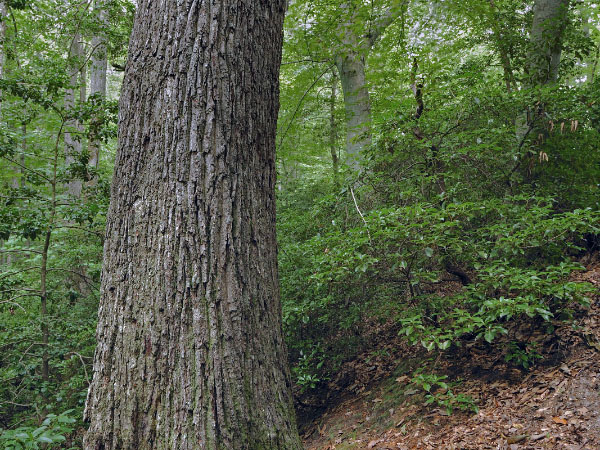
 Departamento de Conservación y Recreación (DCR)
Departamento de Conservación y Recreación (DCR) Conservar. Proteger. Disfrutar.
 Departamento de Conservación y Recreación (DCR)
Departamento de Conservación y Recreación (DCR)  Tabla de contenidos
Tabla de contenidosLlanura costera / Roble piamonte - Haya / Bosques de brezo
In Virginia, forests of this group are widely but locally distributed in small to occasionally large patches across much of the dissected, inner Coastal Plain and Piedmont. Similar forests are known from North Carolina, South Carolina, and Maryland. Typical habitats are submesic, usually north-facing bluffs, and steep ravine slopes with acidic, nutrient-poor soils. Over most of the state, white oak (Quercus alba), northern red oak (Quercus rubra), chestnut oak (Quercus montana), and American beech (Fagus grandifolia) are the major overstory trees. In the southeastern Virginia Coastal Plain, southern red oak (Quercus falcata) and water oak (Quercus nigra) are prominent. Eastern hemlock (Tsuga canadensis) and sweet birch (Betula lenta var. lenta) are occasional associates in the Piedmont. Sourwood (Oxydendrum arboreum), blackgum (Nyssa sylvatica), red maple (Acer rubrum), American holly (Ilex opaca var. opaca) and, in southeastern Virginia, common sweetleaf (Symplocos tinctoria) are common understory trees. Dense colonies of mountain laurel (Kalmia latifolia) or, very locally, great rhododendron (Rhododendron maximum) form a continuous shrub layer. Few herbaceous species occur in the stands. On very steep and rocky bluffs, tree canopies may be quite open as the result of poor establishment and frequent downfalls. Communities in this group are similar to Mesic Mixed Hardwood Forests but usually occupy drier, steeper sites that support fewer mesophytic plants and a greater abundance of heaths.
Referencias: Fleming (2002a), Walton et al. (2001).
Haga clic aquí para ver más fotos de este grupo comunitario ecológico.
 © DCR-DNH, Gary P. Fleming.
© DCR-DNH, Gary P. Fleming.
Se han clasificado dos tipos de comunidades geográficamente discretas sobre la base de análisis regionales de datos de muestras de 39 parcelas (Fig. 1). Haga clic en cualquier código CEGL resaltado a continuación para ver la descripción global de USNVC proporcionada por NatureServe Explorer.

 Descargue una hoja de cálculo de estadísticas de resumen de composición para cada uno de los tipos de comunidad que se enumeran a continuación.
Descargue una hoja de cálculo de estadísticas de resumen de composición para cada uno de los tipos de comunidad que se enumeran a continuación. Volver al principio de la página
siguiente Grupo Ecológico anterior Grupo Ecológico
